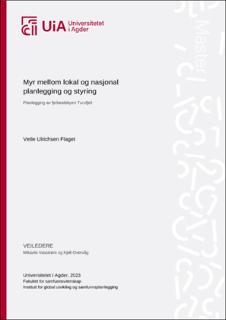| dc.description.abstract | Sammendrag
Formålet med denne masteroppgaven har vært å undersøke hvordan myr blir håndtert i skjæringsfeltet mellom det nasjonale myndighetsnivået og den lokal planleggingsprosess av hytteområdet Turufjell (Flå kommune). På få år har våtmark som økosystem og myr som naturtype fått økt politisk oppmerksomhet. I tillegg til å være et leveområde for diverse arter, leverer myr og våtmark lokale og globale økosystemtjenester samfunnet nyter godt av. I dag blir omdisponering av myrarealer til andre formål ansett som en av de største truslene myr og våtmark står ovenfor. Derimot kan også omdisponering av myrarealer skape andre typer verdier for samfunnet. Hytteutbygging er en aktivitet som forringe store myrarealer, samtidig som hytteutvikling for mange fjellkommuner er en fremtredende strategi for lokal samfunnsutvikling.
Innenfor rammene av Plan- og bygningsloven (PBL) – som ofte blir referert til som «kommunenes lov» – blir motstridende verdier hos ulike interesser på ulike nivåer, håndtert. Derfor er PBL også et av de viktigste verktøyet lokale myndigheter har for å styre lokal samfunnsutvikling. Derimot er også kommunal planlegging en del av et nasjonalt planleggingssystem, der myndigheter på regionalt og nasjonalt nivå kan utøve formell autoritet gjennom retten til innsigelse. For å undersøke myr i skjæringsfeltet mellom nasjonalt og lokalt styringsnivå, har denne masteroppgaven gjennomført en dokumentanalyse av nasjonale styringsdokumenter, og intervjuer av ulike lokale planleggingsaktører tilknyttet Turufjell.
Dokumentanalysen viser at myras verdi og prioritet ovenfor andre samfunnsinteresser har økt. Nye måter å forstå myr og hva dens egenskaper kan utøve for samfunnet, har gjort myr til en tverrsektoiell problematikk som må løses gjennom arealbaserte virkemidler. For lokale planleggingsaktører tilknyttet Turufjell har det å plassere hytter på myr gått fra å være lite ønskelig, til i dag å være en planleggingspraksis som må unngås for enhver pris. Derimot kan andre inngrep knyttet til utbyggingsprosessen av Turufjell som Fjellandsby lokaliseres på myr, om tilstrekkelige avbøtende tiltak er gjennomført. Et sentralt funn kan knyttes til hvordan myrtematikken blir tolket og «oversatt» inn i en lokal kontekst som muliggjør utviklingen av Turufjell, samtidig som myra tilsynelatende blir ivaretatt gjennom planleggingsprosessen.
Abstract
The aim of this thesis has been to study how peatland is handled with in the intersection between the national level of authority and the local planning process for the second homes development of Turufjell (Flå municipality). Recently, wetland (terrestrial habitats) and peatland (a type of wetland) have received increased political attention. In addition to being a habitat for other species, peatland can provide various local and global ecosystem services for the benefit of society. Conversion of peatland to cultural purposes is considered as the biggest threat wetlands and peatlands face today. On the other hand, conversion of peatland to cultural purposes might benefit the social welfare as well. Second home development is considered to fulfil these contradictions. This type of development degrades large areas of peatland, but at the same time, several mountain municipalities consider second home development as, not only an economic activity that employs residents, but as an essential strategy for further locally and socially development.
Opposite values and contradictory interests are supposed to be handled at the local level, within the framework of the Planning and Building Act, which is enforced by the local authoritiy (municipalities). This act is perhaps the most effective policy instrument local authorities uses to become a driving force for local development. At the same time, planning at the local level is a part of a comprehensive national planning system. A system where national authorities can exercise formal authority through the right to object. To investigate peatland and second home development between local and national level, the master thesis has therefore carried out an analyse of governance documents at national level, and several interviews of local planning actors associated with the second home development at Turufjell.
The document analysis expresses how the value of peatland have increased compared to other social interest. New ways of understanding peatland and what it might contribute to the society have turned peatland into a cross-sectorial problem that must be solved through area-based policy instruments. Locating cabins on peatland, has for local planning actors at Turufjell, gone from being less desirable, to become a planning practice that by all means must be avoided. On the other hand, other types of technical interventions related to being a second home development such as Turufjell, can be located on peatland if sufficient mitigating measures have been caried out. A key finding can be linked to how peatland is interpreted and “translated” into a local context that enables the development of Turufjell, while the peatland is apparently taken care of throughout the local planning process. | |
